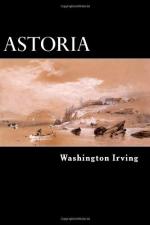The mountains were destitute of game; they came in sight of two grizzly bears, but could not get near enough for a shot; provisions, therefore, began to be scanty. They saw large flights of the kind of thrush commonly called the robin, and many smaller birds of migratory species; but the hills in general appeared lonely and with few signs of animal life. On the evening of the 14th September, they encamped on the forks of the Wind or Bighorn River. The largest of these forks came from the range of Wind River Mountains.
The hunters who served as guides to the party in this part of their route, had assured Mr. Hunt that, by following up Wind River, and crossing a single mountain ridge, he would come upon the head waters of the Columbia. This scarcity of game, however, which already had been felt to a pinching degree, and which threatened them with famine among the sterile heights which lay before them, admonished them to change their course. It was determined, therefore, to make for a stream, which they were informed passed the neighboring mountains, to the south of west, on the grassy banks of which it was probable they would meet with buffalo. Accordingly, about three o’clock on the following day, meeting with a beaten Indian road which led in the proper direction, they struck into it, turning their backs upon Wind River.
In the course of the day, they came to a height that commanded an almost boundless prospect. Here one of the guides paused, and, after considering the vast landscape attentively, pointed to three mountain peaks glistening with snow, which rose, he said, above a fork of Columbia River. They were hailed by the travellers with that joy with which a beacon on a seashore is hailed by mariners after a long and dangerous voyage.
It is true there was many a weary league to be traversed before they should reach these landmarks, for, allowing for their evident height and the extreme transparency of the atmosphere, they could not be much less than a hundred miles distant. Even after reaching them, there would yet remain hundreds of miles of their journey to be accomplished. All these matters were forgotten in the joy at seeing the first landmarks of the Columbia, that river which formed the bourne of the expedition. These remarkable peaks were known as the Tetons; as guiding points for many days, to Mr. Hunt, he gave them the names of the Pilot Knobs.
The travellers continued their course to the south of west for about forty miles, through a region so elevated that patches of snow lay on the highest summits and on the northern declivities. At length they came to the desired stream, the object of their search, the waters of which flowed to the west. It was, in fact, a branch of the Colorado, which falls into the Gulf of California, and had received from the hunters the name of Spanish River, from information given by the Indians that Spaniards resided upon its lower waters.




